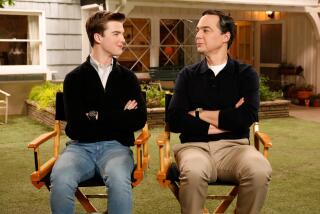Walking in Holden Caulfield’s footsteps through Manhattan
Reporting from New York — Holden Caulfield was a flâneur. That’s not generally how we think of him, this archetype of adolescent alienation, this detester of phonies, this poor little lost boy whose voice — by turns knowing, childlike, cynical and bereft — drives J.D. Salinger’s iconic 1951 novel, “The Catcher in the Rye.” Yet, from the moment, about a quarter of the way through the book, he arrives by train at Manhattan’s now-demolished original Pennsylvania Station building, he is our guide on one of the 20th century’s great literary walking tours.
Planning your trip to Manhattan
THE BEST WAY TO NEW YORK
From LAX, American, United, Delta, Virgin America and JetBlue offer nonstop flights to JFK. US Airways offers connecting flights (change of plane). Restricted round-trip fares begin at $298.
It’s a Saturday night in December 1950, a few days before the start of winter break, and Holden has just been expelled from boarding school again. His plan, if he could be said to have one, is to hole up in a hotel for a few days before returning to his parents’ apartment on the Upper East Side. This shouldn’t be a problem: He has some cash, and he knows the city, having lived here all his life. Holden, though, is 16, lost emotionally and physically, and as his world unravels during the next 48 hours, mostly what he does is walk.
This kind of foot-level interaction with the city begins before Holden ever gets to Manhattan, when he is saying his goodbyes at Pencey Prep. Visiting with a teacher, Old Spencer, he starts to think about the lagoon at the south end of Central Park. “I was wondering,” he tells us, “if it would be frozen over when I got home, and if it was, where did the ducks go. I was wondering where the ducks went when the lagoon got all icy and frozen over. I wondered if some guy came in a truck and took them away to a zoo or something. Or if they just flew away.”
In early March, not much more than a month after Salinger’s death on Jan. 27 at age 91, I stood at the edge of the still icy lagoon and asked myself these very questions as I watched a cluster of ducks among the reeds. Had they just returned, I wondered, or had they spent the winter elsewhere? This, it turns out, is among the novel’s legacies; according to a 2001 New York Times piece, the Department of Parks and Recreation gets several letters and phone calls about the ducks each year.
Here, we see the enduring quality of this novel, which has sold about 65 million copies since it first appeared. For all that readers identify with Holden’s teenage anguish, equally compelling is the way his wanderings bring New York to life. The city is a character in the book, defined by a kind of ongoing instability, in which the only constant is change.
Holden reflects on this while walking through Central Park to the Museum of Natural History. “The best thing … in that museum,” he observes, “was that everything always stayed right where it was. Nobody’d move. You could go there a hundred thousand times, and that Eskimo would still be just finished catching those two fish, the birds would still be on their way south, the deers would still be drinking out of that water hole, with their pretty antlers and their pretty, skinny legs, and that squaw with the naked bosom would still be weaving that same blanket. Nobody’d be different. The only thing that would be different would be you.”
I remember those exhibits also, remember staring at them a hundred thousand times myself. This, in fact, was one of the first attractions of the novel, that the life it described, Holden’s life, was in many ways like my own. I, too, was raised on the Upper East Side and spent time in the places he describes. Like Holden, I was drawn by the stillness of the Museum of Natural History, the idea that it would always be the same.
The irony is that 60 years later, the museum has changed. Many of Holden’s favorite displays have been removed or refurbished, including the so-called Great Canoe, which has been emptied of the 20 Native Americans he so admired, “some of them paddling, some of them just standing around looking tough.”
And yet, outside those exhibition halls, we find another irony: The city is not so very different from the New York he describes. To take a walk in Holden’s footsteps is to appreciate the consistency of the place.
You can walk Holden’s Manhattan in one long afternoon, starting at Penn Station (or perhaps I should say the new Penn Station) and working your way north up Broadway through the theater district to the park. From there, you can check on the ducks in the lagoon, then wander over to the museums, before heading south, past the Central Park Zoo, and down through midtown to Grand Central Station. There are a few hidden landmarks, but for the most part, it’s a city saunter, New York as New Yorkers know it, an insider’s take on the streets.
Holden spends his first night in the city restless, after getting off the train. He gets a room at the Edmont Hotel, where he watches the “perverts” across the airshaft: a gray-haired man who dresses up in women’s clothing and a couple that spits water at each other, laughing “like it was the funniest thing that ever happened.” Later, he will be roughed up by a bellman, after an unsuccessful encounter with a prostitute. The Edmont is fictional; of all the hotels Salinger describes, only one, the Seton, has a real-life analogue. But the actual hotel, at 144 E. 40th St., is squat and seedy, unlike the one in the novel, which is, Holden tells us, “sort of swanky,” with a club called the Wicker Bar.
What Salinger’s getting at is a kind of New York authenticity, a vision of the city as it is. We see this later that first night when Holden goes to a Greenwich Village jazz club called Ernie’s (also fictional), where he runs into some people he knows. This quality of the city as a small town runs throughout the novel, instantly recognizable for anyone who grew up there, who knows the city not as some larger-than-life destination but as home. We see it when Holden makes a date with his on-again, off-again girlfriend Sally to see a Broadway show and then go skating at the Rockefeller Center rink. But such closeness masks a sense of desolation, the feeling that even (or especially) here, he is alone.
On the way to Ernie’s, he reflects on the torpor of the sleeping city: “New York’s terrible when somebody laughs on the street very late at night. You can hear it for miles. It makes you feel so lonesome and depressed.”
The following day, Sunday, is when Holden does most of his walking, checking out of the Edmont and stashing his suitcases in a locker at Grand Central, after agreeing to meet Sally under the Biltmore Hotel clock. This small, gold landmark, beneath which Salinger used to meet his New Yorker editor William Shawn, is still around, although the Biltmore closed in 1981. After the hotel was gutted, the Bank of America Plaza Building was raised around its frame. The clock is now in the lobby of that building, at 335 Madison Ave., tucked discreetly into a corner above the reception desk, an ornate reminder of another time.
From Grand Central, Holden heads across 42nd Street to Times Square. It is on this walk that Salinger establishes the central metaphor of the novel, as Holden follows behind a small boy singing, “If a body catch a body coming through the rye.” It’s a perfect instance of the serendipity of street life, and it immediately raises Holden’s spirits, making him “feel not so depressed anymore.” After buying tickets for “I Know My Love,” starring the Lunts, he wanders up to Central Park, where he looks for his sister Phoebe amid the statuary of the Mall.
Again, we get that sense of New York’s insularity; when Holden asks a girl there whether she knows Phoebe, she does. But as close as he is to coming home, something — in him? in the city? — holds him back. He goes to look for his sister at the Museum of Natural History but can’t bring himself to go inside. Instead, he slips back down to the Biltmore, where he waits for his disastrous date with Sally.
There’s an aimlessness to Holden’s meandering, an ease with the landscape of the city that masks his growing despair. At Rockefeller Center, he picks a fight with Sally, then sees a movie at Radio City Music Hall. Later, he does go home briefly, walking through Central Park at night to see his sister, with whom he shares a special bond.
Through it all, we have a sense of his world narrowing, growing claustrophobic, not like a small town but like the closing of a trap. After a questionable interaction with a former teacher, he returns to Grand Central, where he sleeps in the waiting room. He’s been in Manhattan less than 36 hours, but in that time he’s walked himself in increasingly tight circles, reducing the city and his place within it to the width and breadth of a single bench.
This is what people overlook about “The Catcher in the Rye” — that, for all it tells us of the righteous rage of adolescence, it is also the portrait of a boy losing his grip. Throughout the book, people worry over Holden. “You don’t like anything that’s happening,” Phoebe tells him, and when he protests, she throws down a challenge: “Name one thing.”
This, too, is a reflection of the city, and it’s also one that hasn’t changed. New York can be the most exciting place on the planet, and it can also be the most forlorn. To walk it, to experience it at street level, is to see it in all its complex contradictions, from the Lunts and Rockefeller Center to the Grand Central Station waiting room. This is especially true if you are from here, this tension between exhilaration and loneliness.
In the closing pages of the book, Holden meets Phoebe at the Metropolitan Museum of Art; he has decided to run away. His plan collapses when he sees her cross Fifth Avenue with her own suitcase: Suddenly, his fantasy explodes. Angrily, Phoebe stalks off down Fifth toward the zoo, while Holden follows on the other side of the street.
And here is the genius of the novel, and perhaps the genius of New York. As they visit the zoo and then the carousel, Holden becomes a child again. It’s not that his problems are effaced but that, in this one instant, past and present, memory and moment, merge. “I felt so damn happy,” he says. “God, I wish you could have been there.”
All these years later, with each step we take along his odd and winding ramble through Manhattan, we are.
Ulin is book editor of The Times.
More to Read
Sign up for The Wild
We’ll help you find the best places to hike, bike and run, as well as the perfect silent spots for meditation and yoga.
You may occasionally receive promotional content from the Los Angeles Times.







